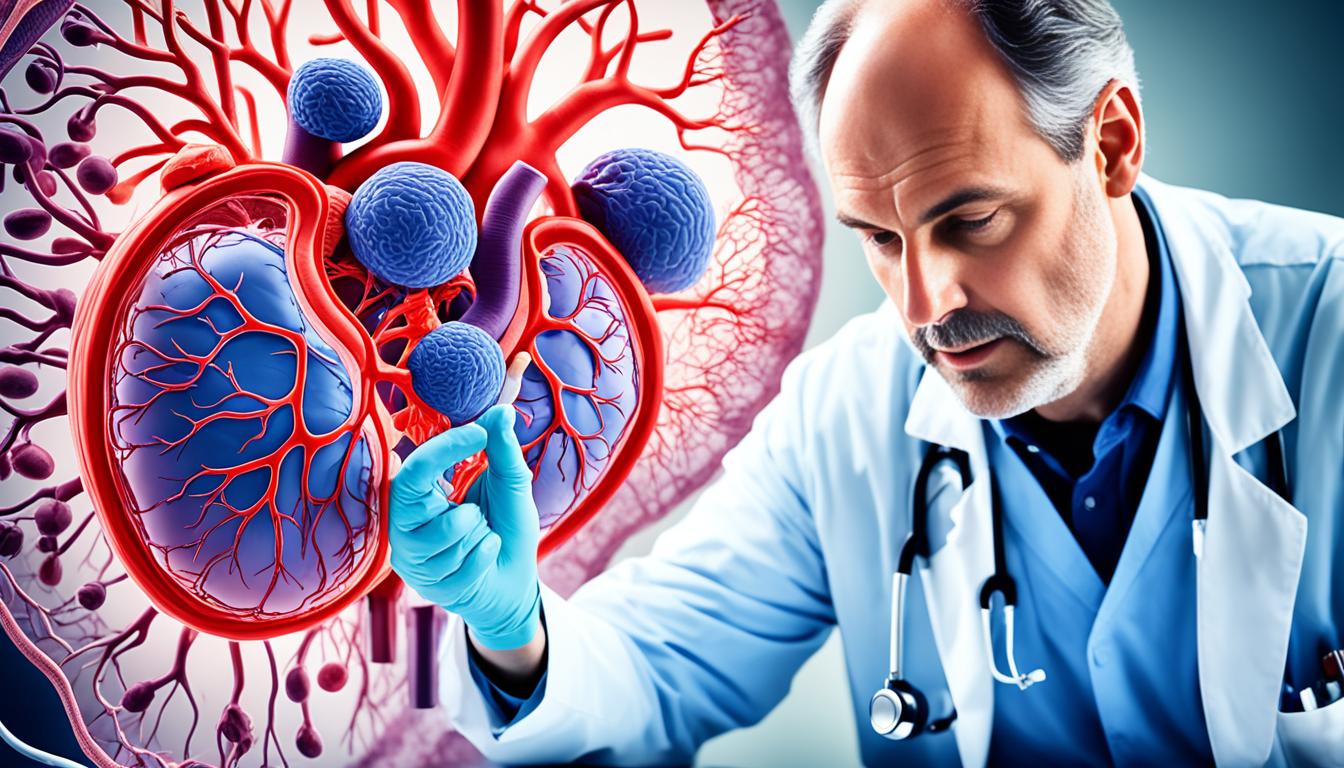Transposition of the great arteries is a heart defect from birth. It affects the main arteries’ position in the heart. This can lead to serious health issues and needs careful treatment.
The reason behind this defect is not fully understood. But, it likely comes from the heart forming abnormally in the womb. Any early hiccup in heart development can lead to such conditions.
Doctors can spot this issue before birth or right after using special tests. These tests, like ultrasound, let them see the baby’s heart clearly. They’re vital for early detection and treatment planning.
Surgery is often needed to fix the arteries’ position. Doctors may perform an arterial switch operation. This surgery helps the blood flow correctly. Specialists in pediatric cardiology take care of kids with such heart issues.
Now, there’s a new hope with stem cell therapy for this heart condition. Stem cells can repair damaged heart tissue and boost its function. Although research is ongoing, it could change how we treat children with this defect.
Key Takeaways:
- Transposition of the great arteries is a congenital heart defect where the two main arteries in the heart are switched in position.
- The exact cause of transposition of the great arteries is unknown, but it is believed to be due to abnormal heart development during pregnancy.
- Diagnosis is typically made during pregnancy or shortly after birth through imaging tests.
- Treatment options include surgery to correct the positioning of the arteries.
- Stem cell therapy shows promise in regenerating damaged heart tissue and may play a role in the treatment of transposition of the great arteries.
Symptoms of Transposition of the Great Arteries
Transposition of the great arteries (TGA) is a serious heart issue. Early detection and action are key. This makes knowing TGA symptoms essential for parents and doctors. It helps them get the right medical care for a child.
Signs of TGA include:
- Cyanosis: This is when the skin and lips turn blue. It happens because blood isn’t getting enough oxygen.
- Rapid breathing: Infants might breathe fast or struggle to breathe.
- Poor feeding: They may find eating hard or not want to eat.
- Fatigue: Babies could be very tired or seem weak.
These signs often show up in a baby’s first few days or weeks. But, their severity can differ depending on the TGA case.
If TGA is suspected, a fetal echocardiogram might be done. This imaging test is safe and checks the baby’s heart during pregnancy. It helps diagnose TGA early.
By spotting TGA early and acting quickly, it can be managed. If symptoms are noticed, or the baby’s heart health seems off, seek medical help fast. A timely diagnosis and the right steps, like TGA surgery, can make a big difference in the baby’s health.
Causes and Risk Factors of Transposition of the Great Arteries
The cause of transposition of the great arteries isn’t fully known. However, experts think it happens when the heart doesn’t form correctly before birth. This causes the two big arteries to be in the wrong places.
There are some known risks that make transposition of the great arteries more likely. Maternal diabetes is one of them. Studies show that if diabetes isn’t controlled during pregnancy, it might add to the risk of this heart problem. So, it’s very important for moms-to-be with diabetes to keep their blood sugar in check.
Genetic disorders, like Down syndrome, also link to a higher chance of this heart issue. It’s been found that people with Down syndrome often have congenital heart problems, including this one. For families in such situations, getting genetic advice and tests is key.
If transposition of the great arteries runs in the family, this too might mean a higher risk. Some research hints at a genetic link to this heart condition. Those with a relative who has this condition should tell the child’s doctor. Regular check-ups can help manage any risks.
In most cases, this condition happens without a clear reason and isn’t the parents’ fault. But knowing the risks can help doctors watch out for high-risk cases. This early attention can make a big difference in caring for children with this condition.
Risk Factors for Transposition of the Great Arteries
| Risk Factors |
|---|
| Maternal diabetes |
| Genetic syndromes (e.g., Down syndrome) |
| Family history of congenital heart defects |
Understanding the root causes and risks of transposition of the great arteries is key. It helps in preventing and catching this condition early. With this knowledge, doctors specializing in pediatric cardiology can help families better. They can offer the right care for infants with this heart issue.
Advancements in Stem Cell Therapy for Transposition of the Great Arteries
In recent years, stem cell therapy has advanced significantly. It shows great promise for those with transposition of the great arteries. These stem cells, with their regenerative powers, aim at fixing the heart’s damaged parts.
Studies in animals and early clinical trials underline stem cell therapy’s promise. They show that when transplanted, these special cells can turn into heart cells. They help repair the transposed arteries, bringing hope for those with this heart issue.
Still, more research is vital to grasp the therapy’s full effect and safety for this specific heart condition. Scientists are working to refine how stem cells are delivered, the best dose to use, and when to give them. Their goal is to make the treatment more beneficial and reduce any potential harm.
The growth in using stem cell therapy for transposition of the great arteries is a big leap for pediatric cardiology. If further research and trials confirm its success, this method could offer a safe, non-invasive, and perhaps a curative solution for newborns with this challenging heart problem.

